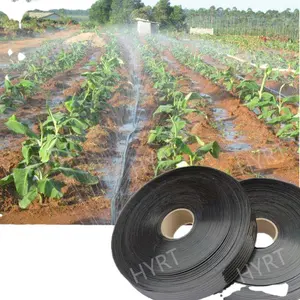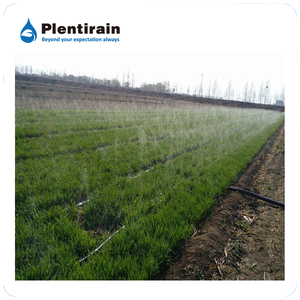(1978 products available)











































































































































































































A watering hose with holes, commonly referred to as a soaker hose, is a gardening tool designed to deliver water directly to the roots of plants. Unlike traditional hoses, soaker hoses are permeable along their length. This allows water to seep out of tiny holes or pores in the hose material. The primary advantage of using a soaker hose is that it provides deep watering to plants while minimizing water evaporation and reducing water runoff. This is particularly beneficial in areas with sandy soil or during hot weather when water can easily evaporate. Soaker hoses are typically made from durable materials like recycled rubber or polyethylene, and they come in various lengths and diameters to accommodate different garden sizes and layouts.
When a soaker hose is laid out in a garden, water trickles out through the holes, soaking the soil and reaching plant roots. This method keeps the topsoil from becoming too wet, reducing the chances of weeds growing and plants experiencing diseases. These hoses are ideal for vegetable gardens, flower beds, and trees, as they ensure efficient watering without over-saturation. They work well in both flat and sloped areas and can be used with drip irrigation systems or standalone. Additionally, soaker hoses can help save water, as they deliver the moisture where it is needed most, thus making them an eco-friendly and economical choice for irrigation.
Various kinds of watering hoses with holes are available on the market, each designed to meet particular watering needs in gardens. Understanding these different kinds can help one choose the right watering hose for the garden.
Regular soaker hoses
Regular soaker hoses are usually made from porous rubber or recycled materials. They are designed to seep water along their entire length, making them perfect for deep watering over a larger area. They are great for vegetable gardens, flower beds, and trees, as they provide consistent moisture. Regular soaker hoses come in various lengths and diameters to fit different garden sizes and can be connected in series for larger areas.
Cloth-covered soaker hoses
These are made from a porous inner hose wrapped in a protective cloth outer layer. The cloth covering adds durability and some UV protection, making them last longer in exposed areas. They are also less likely to get damaged by lawn mowers or pets. Cloth-covered soaker hoses work well for all types of gardens and are easy to lay out in various shapes.
Polyethylene soaker hoses
These are made from recycled, high-density polyethylene. This material is resistant to kinking and cracking, even in the sun. They have tiny holes along the hose for water to flow out. Polyethylene soaker hoses are lightweight, flexible, and strong, making them ideal for any garden. They are also affordable and eco-friendly because they use recycled plastic.
Expandable watering hoses
Expandable watering hoses are a modern solution for gardens. They are made from a mix of latex and high-quality nylon. When water is turned on, these hoses expand up to three times their original size. They are lightweight and easy to store because they shrink back when the water is turned off. They don't have holes, so they are not meant for soaking like soaker hoses. Instead, they are great for reaching far areas of the garden and provide a strong water flow for watering plants and filling buckets. They come in many lengths and are suitable for small and large gardens. Expandable hoses are also resistant to tangling and twisting, making watering less frustrating.
Flat Soaker Hoses
These are mostly made from recycled rubber and are designed to lay flat on the surface of the soil. They have small porous holes along the length of the hose that allows water to seep out. The water goes directly to the roots of the plants. This reduces water wastage and keeps the surrounding soil moist. These hoses are ideal for rows of plants that are planted in straight lines such as vegetables and flowers. They work well in both sandy soils and clay soils.
Round Soaker Hose
Round soaker hoses are designed to be used in circular patterns. They are suited for plants that are planted in clusters or for potted plants. They are mostly made from recycled rubber and are capable of conserving water and reducing plant diseases.
Expandable Soaker Hose
This type of hose is designed to stretch and contract based on the amount of water that is flowing through it. It is made from a combination of rubber and plastic. It is a good fit for plants that are of different sizes and for gardens that have varying planting areas. It is also suitable for storage as it can be compacted when not in use.
Permeable Soaker Hose
The permeable soaker hose is made from materials that allow water to seep out through the walls of the hose. It is designed to be buried underground. This hose works well for irrigation systems where the water needs to be applied directly to the root zone of the plants.
Irrigation
The soaker hose is a drip irrigation system that delivers water directly to the plant's roots. This is important for plants with specific watering needs or for those in sandy soils that lose moisture quickly. The soaker hose can be used in vegetable gardens, flower beds, and even shrubs or trees.
Dust control
A perforated watering hose can be used to control dust on construction sites, dirt roads, or unpaved areas. Watering holes wet the surface and keep the dust particles down, preventing dust clouds and reducing the need for constant water refills.
Containment of spills
Perforated hoses are used to contain liquid spills in industrial settings. The hose absorbs the liquid and prevents it from spreading, keeping the workplace safe and clean. Some hoses are designed with geotextile fabrics that filter out solids and allow water to pass through.
Cooling
Watering hoses are used in cooling applications. For example, they can be used to cool concrete during curing, which prevents cracks, or in power plants to cool equipment or control temperature in areas with heat.
Soil moisture management
Perforated hoses are used for monitoring soil moisture levels. Some hoses are designed with sensors that provide data on soil moisture content. This information can be used to optimize irrigation scheduling, preventing overwatering or underwatering of crops.
Green roof irrigation
These hoses are ideal for irrigating green roofs, which integrate vegetation into building rooftops. This provides even water distribution across the roof, promoting healthy plant growth and contributing to stormwater management.
Picking the right soaker hose for the garden is critical to ensure proper watering. Here are some important things to consider when choosing a watering hose with holes:
Plants' watering needs
Different plants have different watering needs. Some need more water, while others need less. It's necessary to know what the garden plants need. For example, if a garden has plants that need a lot of water, choose a hose that gives more water. But if the plants need less, choose one that gives less water. Therefore, when choosing a soaker hose, consider the type of plants and their watering needs. It ensures that all plants receive the right amount of water for healthy growth.
Length and size of the garden
When choosing a soaker hose, consider the garden size and hose length. A longer hose is needed for a large garden to reach all areas. But for a small garden, a shorter hose is sufficient. Also, ensure the hose can fit in the garden spaces. A well-fitted hose waters the garden better. Therefore, consider the garden size and hose length to choose the right soaker hose for effective irrigation.
Material and durability
Consider the soaker hose material and its durability. Most hoses are made from recycled rubber or vinyl. Hoses made from recycled rubber are stronger and last longer. Vinyl hoses are lighter and cheaper but may not last as long. Choose a hose material that will withstand garden use. Also, check for quality features like reinforced construction and resistance to kinks or leaks. Opt for a durable hose that can handle the rigors of gardening and save money in the long run.
Pressure and flow rate
Think about the water pressure and flow rate when choosing a soaker hose. Soaker hoses work well with low to medium water pressure. High water pressure can damage them. Also, ensure the hose matches the flow rate of the water source, such as a tap or pump. If the hose can't handle the flow rate, it may burst or get damaged. Therefore, consider the water pressure and flow rate to select a suitable soaker hose for the irrigation system.
Q1: How long do perforated hoses last?
A1: The lifespan of a perforated hose can vary depending on factors such as material quality, usage, maintenance, and environmental conditions. Generally, a well-maintained perforated hose made of durable materials like PVC or rubber can last several years. Regular inspection for signs of wear, damage, or clogging and proper cleaning and storage can help extend the hose's lifespan.
Q2: Can users cut a soaker hose to make it fit their needs?
A2: Yes, many soaker hoses can be cut to the desired length. However, it's important to check the manufacturer's guidelines before cutting. Some hoses have specific connection points or are designed to be used at full length, so cutting them without guidance could damage the hose or affect its performance.
Q3: How can one unclog a soaker hose?
A3: To unclog a soaker hose, try the following steps: First, flush the hose with clean water by connecting it to a water source and letting the water flow through it in the opposite direction. If that doesn't work, mix a solution of one part vinegar and three parts baking soda, pour it into the hose, and let it sit for about 30 minutes before flushing it out with water. Use a gentle brush or a stick to dislodge any stubborn clogs if the hose is still blocked.